Assessment of Ecological Vulnerability on Northern Sand Prevention Belt of China Based on the Ecological Pressure–Sensibility–Resilience Model
Abstract
1. Introduction
2. Materials and Methods
2.1. Study Region
2.2. Data Sources
2.3. Assessment Index System of Ecological Vulnerability
2.4. The Index of Ecological Vulnerability
3. Results
3.1. Spatiotemporal Dynamics of the Indicators
3.2. Spatiotemporal Dynamics of Ecological Vulnerability
4. Discussion
5. Conclusions
Author Contributions
Funding
Institutional Review Board Statement
Informed Consent Statement
Data Availability Statement
Acknowledgments
Conflicts of Interest
References
- Zhang, G.L.; Dong, J.W.; Xiao, X.M.; Hu, Z.M.; Sheldon, S. Effectiveness of ecological restoration projects in Horqin Sandy Land, China based on SPOT-VGT NDVI data. Ecol. Eng. 2012, 38, 20–29. [Google Scholar] [CrossRef]
- Staudinger, M.D.; Grimm, N.B.; Staudt, A.; Carter, S.L.; Chapin, F.S. Impacts of Climate Change on Biodiversity, Ecosystems, and Ecosystem Services: Technical Input to the 2013 National Climate Assessment; Cooperative Report to the 2013 National Climate Assessment; United States Global Change Research Program: Washington, DC, USA, 2012.
- Li, Q.; Shi, X.Y.; Wu, Q.Q. Effects of protection and restoration on reducing ecological vulnerability. Sci. Total Environ. 2021, 761, 143180. [Google Scholar] [CrossRef]
- Hu, X.J.; Ma, C.M.; Huang, P.; Guo, X. Ecological vulnerability assessment based on AHP-PSR method and analysis of its single parameter sensitivity and spatial autocorrelation for ecological protection—A case of Weifang City, China. Ecol. Indic. 2021, 125, 107464. [Google Scholar] [CrossRef]
- De Lange, H.J.; Sala, S.; Vighi, M.; Faber, J.H. Ecological vulnerability in risk assessment—A review and perspectives. Sci. Total Environ. 2020, 408, 3871–3879. [Google Scholar] [CrossRef] [PubMed]
- Beroya-Eitner, M.A. Ecological vulnerability indicators. Ecol. Indic. 2016, 60, 329–334. [Google Scholar] [CrossRef]
- Weißhuhn, P.; Müller, F.; Wiggering, H. Ecosystem vulnerability review: Proposal of an interdisciplinary ecosystem assessment approach. Environ. Manag. 2018, 61, 904–915. [Google Scholar] [CrossRef] [PubMed]
- Hou, K.; Tao, W.D.; Wang, L.M.; Li, X.X. Study on hierarchical transformation mechanisms of regional ecological vulnerability and its applicability. Ecol. Indic. 2020, 114, 106343. [Google Scholar] [CrossRef]
- Zimmerman, J.K.; Willig, M.R.; Hernández-Delgado, E.A. Resistance, resilience, and vulnerability of social-ecological systems to hurricanes in Puerto Rico. Ecosphere 2020, 11, e03159. [Google Scholar] [CrossRef]
- Hong, W.Y.; Jiang, R.R.; Yang, C.Y.; Zhang, F.F.; Su, M.; Liao, Q. Establishing an ecological vulnerability assessment indicator system for spatial recognition and management of ecologically vulnerable areas in highly urbanized regions: A case study of Shenzhen, China. Ecol. Indic. 2016, 69, 540–547. [Google Scholar] [CrossRef]
- Xia, M.; Jia, K.; Zhao, W.W.; Liu, S.L.; Wei, X.Q.; Wang, B. Spatio-temporal changes of ecological vulnerability across the Qinghai-Tibetan Plateau. Ecol. Indic. 2021, 123, 107274. [Google Scholar] [CrossRef]
- Ghiasvand, F.; Babaei, A.A.; Yazdani, M.; Birgani, Y.T. Spatial modeling of environmental vulnerability in the biggest river in Iran using geographical information systems. J. Environ. Health Sci. Eng. 2021. [Google Scholar] [CrossRef]
- Song, G.B.; Li, Z.; Yang, Y.G.; Semakula, H.M.; Zhang, S.S. Assessment of ecological vulnerability and decision-making application for prioritizing roadside ecological restoration: A method combining geographic information system, Delphi survey and Monte Carlo simulation. Ecol. Indic. 2015, 52, 57–65. [Google Scholar] [CrossRef]
- Dzoga, M.; Simatele, D.; Munga, C. Assessment of ecological vulnerability to climate variability on coastal fishing communities, A study of Ungwana Bay and Lower Tana Estuary, Kenya. Ocean Coast. Manag. 2018, 163, 437–444. [Google Scholar] [CrossRef]
- Xie, Z.L.; Li, X.Z.; Jiang, D.G.; Li, S.W.; Yang, B.; Chen, S.L. Threshold of island anthropogenic disturbance based on ecological vulnerability Assessment-A case study of Zhujiajian Island. Ocean Coast. Manag. 2019, 167, 127–136. [Google Scholar] [CrossRef]
- Shi, H.H.; Lu, J.F.; Zheng, W.; Sun, J.K.; Li, J.; Guo, Z.; Huang, J.T.; Yu, S.T.; Yin, L.T.; Wang, Y.Z.; et al. Evaluation system of coastal wetland ecological vulnerability under the synergetic influence of land and sea: A case study in the Yellow River Delta, China. Mar. Pollut. Bull. 2020, 161, 111735. [Google Scholar] [CrossRef] [PubMed]
- Xue, L.Q.; Wang, J.; Zhang, L.C.; Wei, G.H.; Zhu, B.L. Spatiotemporal analysis of ecological vulnerability and management in the Tarim River Basin, China. Sci. Total Environ. 2019, 649, 876–888. [Google Scholar] [CrossRef] [PubMed]
- Berrouet, L.M.; Machado, J.; Villegas-Palacio, C. Vulnerability of socio-ecological systems, A conceptual framework. Ecol. Indic. 2018, 84, 632–647. [Google Scholar] [CrossRef]
- Zhou, J.H.; Huang, X.X. A review on the assessment methods of ecological vulnerability. Yunnan Geogr. Environ. Res. 2008, 20, 55–60. [Google Scholar]
- Zhong, X.J.; Sun, B.P.; Zhao, Y.; Li, J.R.; Zhou, X.S.; Wang, Y.Q.; Qiu, Y.D.; Feng, L. Ecological vulnerability evaluation based on principal component analysis in Yunnan province. Ecol. Environ. Sci. 2011, 20, 109–113. [Google Scholar]
- Yu, X.; Li, Y.; Xi, M.; Kong, F.L.; Pang, M.Y.; Yu, Z.D. Ecological vulnerability analysis of Beidagang National Park, China. Front. Earth Sci. 2019, 13, 385–397. [Google Scholar] [CrossRef]
- Li, R.; Han, R.; Yu, Q.R.; Qi, S.; Guo, L. Spatial heterogeneous of ecological vulnerability in arid and semi-arid area: A case of the Ningxia Hui Autonomous Region, China. Sustainability 2020, 12, 4401. [Google Scholar] [CrossRef]
- Ghosh, S.; Das, A. Urban expansion induced vulnerability assessment of East Kolkata Wetland using Fuzzy MCDM method. Remote Sens. Lett. 2019, 13, 191–203. [Google Scholar] [CrossRef]
- Li, L.W.; Liu, Z.; Bai, Y.L.; Sheng, J. Environmental vulnerability evaluation of Yellow River Delta coast based on AHP-CVI technology. Ecol. Environ. Sci. 2018, 27, 297–303. [Google Scholar]
- Wu, C.S.; Liu, G.H.; Huang, C.; Liu, Q.S.; Guan, X.D. Ecological vulnerability assessment based on fuzzy analytical method and analytic hierarchy process in Yellow River Delta. Int. J. Environ. Res. Pub. Health 2018, 15, 855. [Google Scholar] [CrossRef]
- Park, Y.S.; Chon, T.S.; Kwak, I.S.; Lek, S. Hierarchical community classification and assessment of aquatic ecosystems using artificial neural networks. Sci. Total Environ. 2004, 327, 105–122. [Google Scholar] [CrossRef]
- Guo, B.; Kong, W.H.; Han, F.; Wang, J.J.; Jiang, L.; Lu, Y.F. Dynamic monitoring of ecological vulnerability in the semi-arid desert and steppe ecological zone of Northern China based on RS and its driving mechanism analysis. J. Tropical Subtropical Bot. 2018, 26, 1–12, (In Chinese with English abstract). [Google Scholar]
- Defne, Z.; Aretxabaleta, A.L.; Ganju, N.K.; Kalra, T.S.; Jones, D.K.; Smith, K.E.L. A geospatially resolved wetland vulnerability index: Synthesis of physical drivers. PLoS ONE 2020, 15, e0228504. [Google Scholar] [CrossRef]
- Malekmohammadi, B.; Jahanishakib, F. Vulnerability assessment of wetland landscape ecosystem services using driver-pressure-state-impact-response (DPSIR) model. Ecol. Indic. 2017, 82, 293–303. [Google Scholar] [CrossRef]
- Ippolito, A.; Sala, S.; Faber, J.H.; Vighi, M. Ecological vulnerability analysis: A river basin case study. Sci. Total Environ. 2010, 408, 3880–3890. [Google Scholar] [CrossRef] [PubMed]
- Pang, L.H.; Kong, F.L.; Xi, M.; Li, Y. Spatio-temporal changes of ecological vulnerability in the Jiaozhou Bay coastal zone. J. East China Normal Univ. 2018, 3, 222–233. [Google Scholar]
- Bueno-Pardo, J.; Nobre, D.; Monteiro, J.N.; Sousa, P.M.; Costa, E.F.S.; Baptista, V.; Ovelheiro, A.; Vieira, V.M.N.C.S.; Chícharo, L. Climate change vulnerability assessment of the main marine commercial fish and invertebrates of Portugal. Sci. Rep. 2021, 11, 2958. [Google Scholar] [CrossRef] [PubMed]
- Nguyen, A.K.; Liou, Y.A.; Li, M.H.; Tran, T.A. Zoning eco-environmental vulnerability for environmental management and protection. Ecol. Indic. 2016, 69, 100–117. [Google Scholar] [CrossRef]
- Yang, H.F.; Zhai, G.F.; Zhang, Y. Ecological vulnerability assessment and spatial pattern optimization of resource-based cities: A case study of Huaibei City, China. Hum. Ecol. Risk Assess. 2021, 27, 606–625. [Google Scholar] [CrossRef]
- Zolkos, S.G.; Jantz, P.; Cormier, T.; Iverson, L.R.; McKenney, D.W.; Goetz, S.J. Projected tree species redistribution under climate change: Implications for ecosystem vulnerability across protected areas in the Eastern United States. Ecosystems 2015, 18, 202–220. [Google Scholar] [CrossRef]
- Wang, X.F.; Li, Y.H.; Chu, B.Y.; Liu, S.R.; Yang, D.; Luan, J.W. Spatiotemporal dynamics and driving forces of ecosystem changes: A case study of the national barrier zone, China. Sustainability 2020, 12, 6680. [Google Scholar] [CrossRef]
- Su, K.; Sun, X.T.; Wang, Y.R.; Chen, L.; Yue, D.P. Spatial and temporal variations of ecosystem patterns in Northern sand control barrier belt based on GIS and RS. Trans. Chin. Soc. Agric. Mach. 2020, 51, 226–236, (In Chinese with English abstract). [Google Scholar]
- Aronson, J.; Goodwin, N.; Orlando, L.; Eisenberg, C.; Cross, A.T. A world of possibilities: Six restoration strategies to support the United Nation’s Decade on Ecosystem Restoration. Restor. Ecol. 2020, 28, 730–736. [Google Scholar] [CrossRef]
- Zhang, X.Q.; Wang, L.K.; Fu, X.S.; Li, H.; Xu, C.D. Ecological vulnerability assessment based on PSSR in Yellow River Delta. J. Clean. Prod. 2017, 167, 1106–1111. [Google Scholar] [CrossRef]
- Wei, W.J.; Wang, B.; Niu, X. Soil erosion reduction by Grain for Green Project in desertification areas of Northern China. Forests 2020, 11, 473. [Google Scholar] [CrossRef]
- Chen, X.W.; Li, X.M.; Eladawy, A.; Yu, T.; Sha, J.M. A multi-dimensional vulnerability assessment of Pingtan Island (China) and Nile Delta (Egypt) using ecological Sensitivity-Resilience-Pressure (SRP) model. Hum. Ecol. Risk Assess. 2021. [Google Scholar] [CrossRef]
- Hou, K.; Li, X.X.; Zhang, J. GIS analysis of changes in ecological vulnerability using a SPCA Model in the Loess Plateau of Northern Shaanxi, China. Int. J. Environ. Res. Public Health 2015, 12, 4292–4305. [Google Scholar] [CrossRef]
- Yang, Y.J.; Ren, X.F.; Zhang, S.L.; Chen, F.; Hou, H.P. Incorporating ecological vulnerability assessment into rehabilitation planning for a post-mining area. Environ. Earth Sci. 2017, 76, 245. [Google Scholar] [CrossRef]
- Lv, X.J.; Xiao, W.; Zhao, Y.L.; Zhang, W.K.; Li, S.C.; Sun, H.X. Drivers of spatio-temporal ecological vulnerability in an arid, coal mining region in Western China. Ecol. Indic. 2019, 106, 105475. [Google Scholar] [CrossRef]
- Zou, T.H.; Yoshino, K. Environmental vulnerability evaluation using a spatial principal component approach in the Daxing’anling region, China. Ecol Indic. 2017, 78, 405–415. [Google Scholar] [CrossRef]
- Sun, P.J.; Xiu, C.L.; Wang, Z.Z. Assessment of Ming-city’s ecological-fragility on changes based on the PSE model. Econ. Geogr. 2010, 30, 1354–1359, (In Chinese with English abstract). [Google Scholar]
- Kerner, D.A.; Thomas, J.S. Resilience attributes of social-ecological systems: Framing metrics for management. Resources 2014, 3, 672–702. [Google Scholar] [CrossRef]
- Jarraha, M.; Mayel, S.; Tatarko, J.; Funk, R.; Kuka, K. A review of wind erosion models: Data requirements, processes, and validity. Catena 2020, 187, 104388. [Google Scholar] [CrossRef]
- Dossou, J.F.; Li, X.X.; Sadek, M.; Almouctar, M.A.S.; Mostafa, E. Hybrid model for ecological vulnerability assessment in Benin. Sci. Rep. 2021, 11, 2449. [Google Scholar] [CrossRef] [PubMed]
- Guo, B.; Fan, Y.W.; Yang, F.; Jiang, L.; Yang, W.N.; Chen, S.T.; Gong, R.; Liang, T. Quantitative assessment model of ecological vulnerability of the Silk Road Economic Belt, China, utilizing remote sensing based on the partition–integration concept. Geomat. Nat. Hazards Risk 2019, 10, 1346–1366. [Google Scholar] [CrossRef]
- Ortega, M.; Pascual, S.; Elena-Rosselló, R.; Rescia, A.J. Land-use and spatial resilience changes in the Spanish olive socio-ecological landscape. Appl. Geogr. 2020, 117, 102171. [Google Scholar] [CrossRef]
- Christmann, G.B.; Balgar, K.; Mahlkow, N. Local constructions of vulnerability and resilience in the context of climate change. A comparison of Lübeck and Rostock. Soc. Sci. 2014, 3, 142–159. [Google Scholar] [CrossRef]
- Anjos, L.J.; de Toledo, P.M. Measuring resilience and assessing vulnerability of terrestrial ecosystems to climate change in South America. PLoS ONE 2018, 13, e0194654. [Google Scholar] [CrossRef] [PubMed]
- Zou, H.; Duan, X.J.; Ye, L.; Wang, L. Locating sustainability issues: Identification of ecological vulnerability in Mainland China’s Mega-Regions. Sustainability 2017, 9, 1179. [Google Scholar] [CrossRef]
- Liu, J.H.; Zou, C.X.; Gao, J.X.; Ma, S.; Wang, W.J.; Wu, K.; Liu, Y. Location determination of ecologically vulnerable regions in China. Bio. Sci. 2015, 23, 725–732. [Google Scholar] [CrossRef]
- Zhu, F.Y.; Lu, H.Y.; Zhang, W.C.; Chen, Y.Y.; Zeng, L.; Xu, Z.W.; Zhang, H.Z.; Dong, L.N. Mapping deserts and sandy fields in Northern China and surface process analysis based on 3S techniques. Quat. Sci. 2013, 33, 197–205, (In Chinese with English abstract). [Google Scholar]
- Zhu, J.J.; Zheng, X.; Yan, Q.L. Assessment of Impacts of the Three-North Protective Forest Program on Ecological Environments by Remote Sensing Technology-Launched after 30 Years (1978–2008); Science Press: Beijing, China, 2016. [Google Scholar]
- Zhu, J.J.; Song, L.N. A review of ecological mechanisms for management practices of protective forests. J. For. Res. 2021, 32, 435–448. [Google Scholar] [CrossRef]
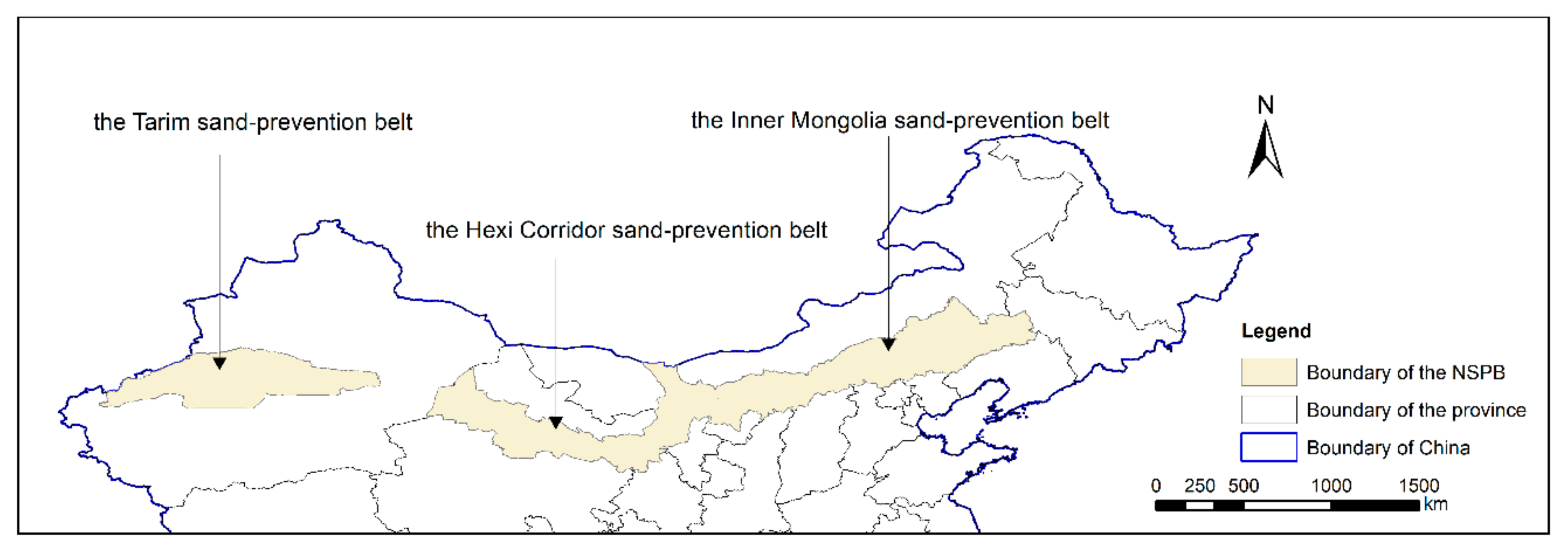
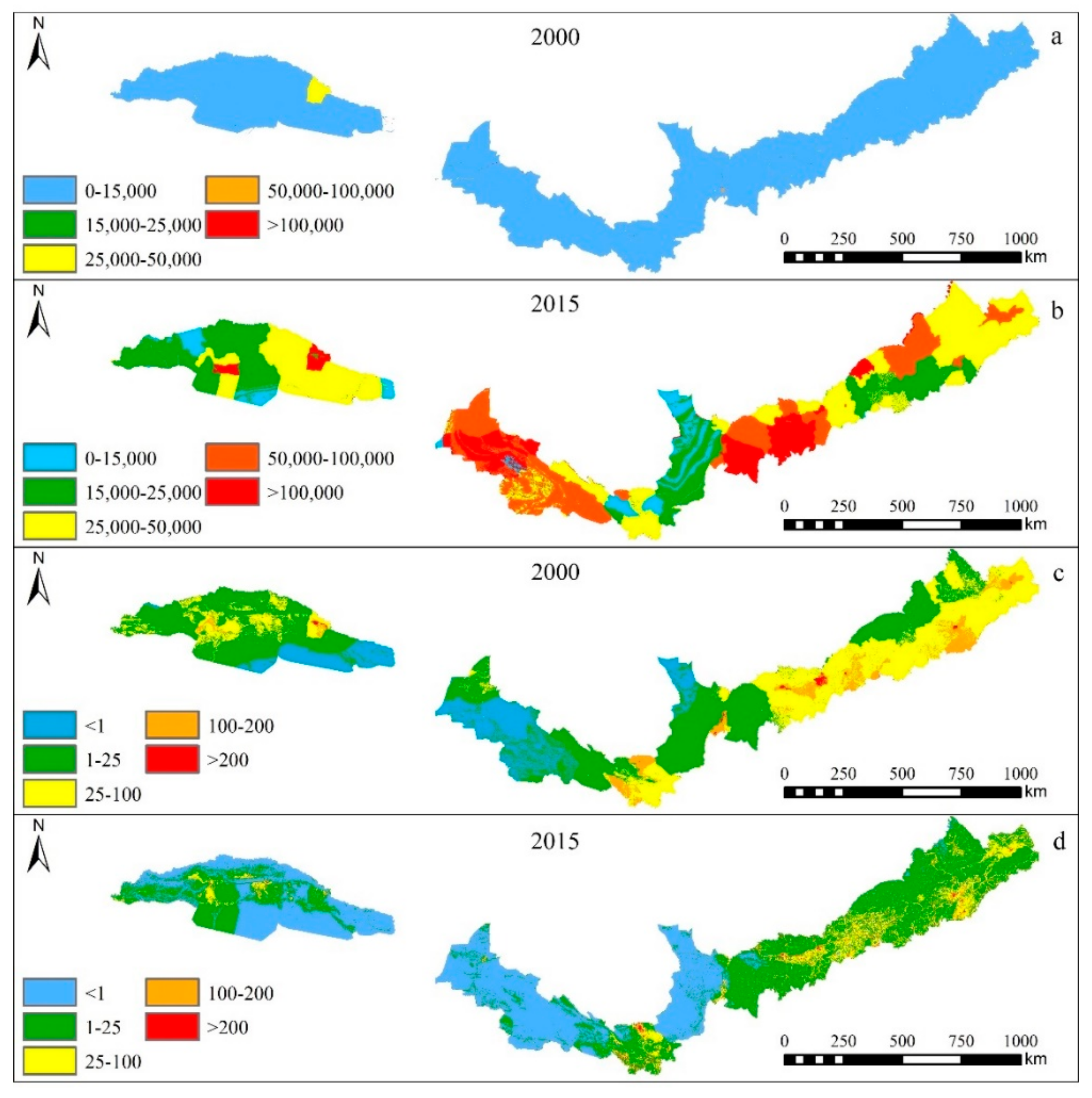
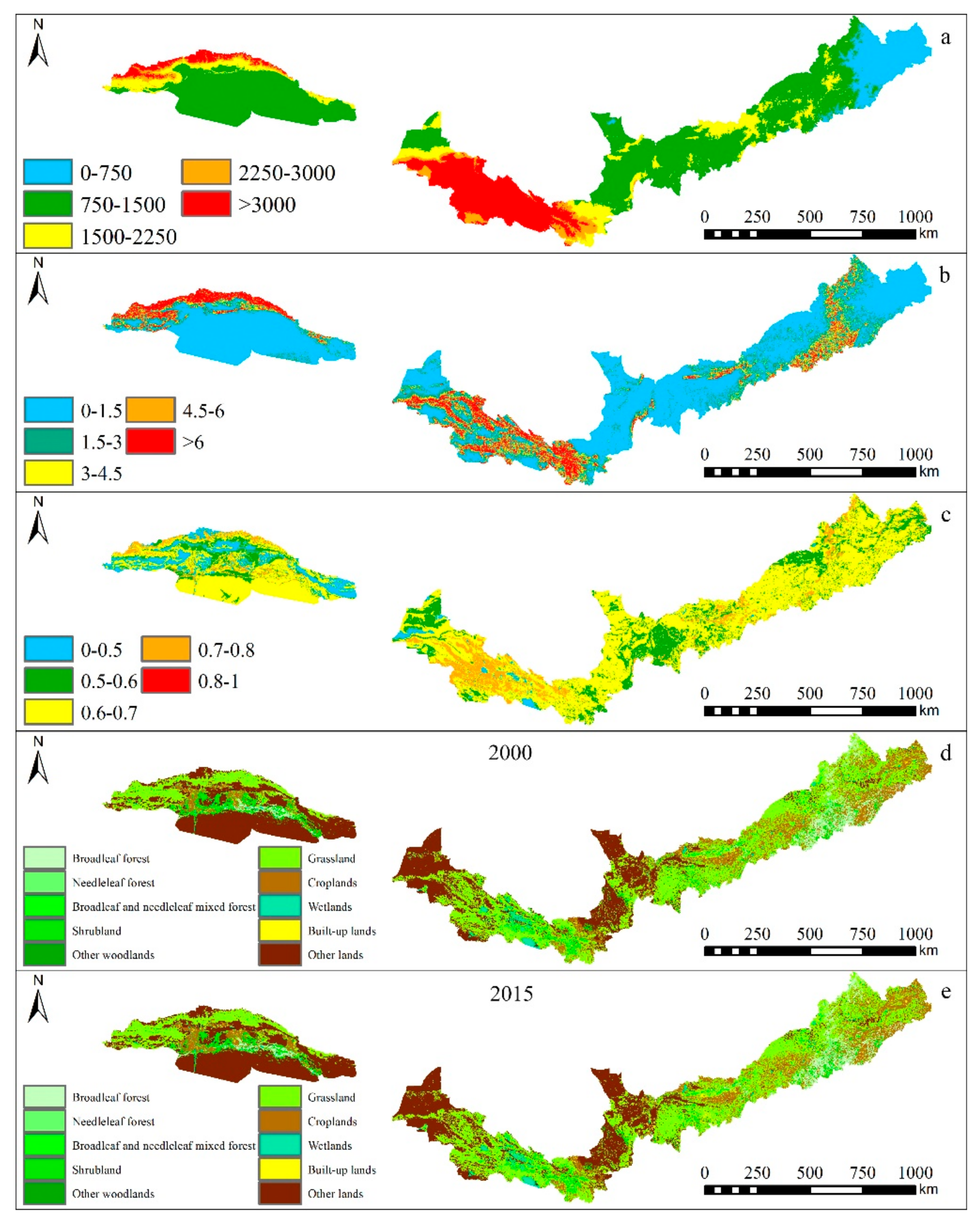
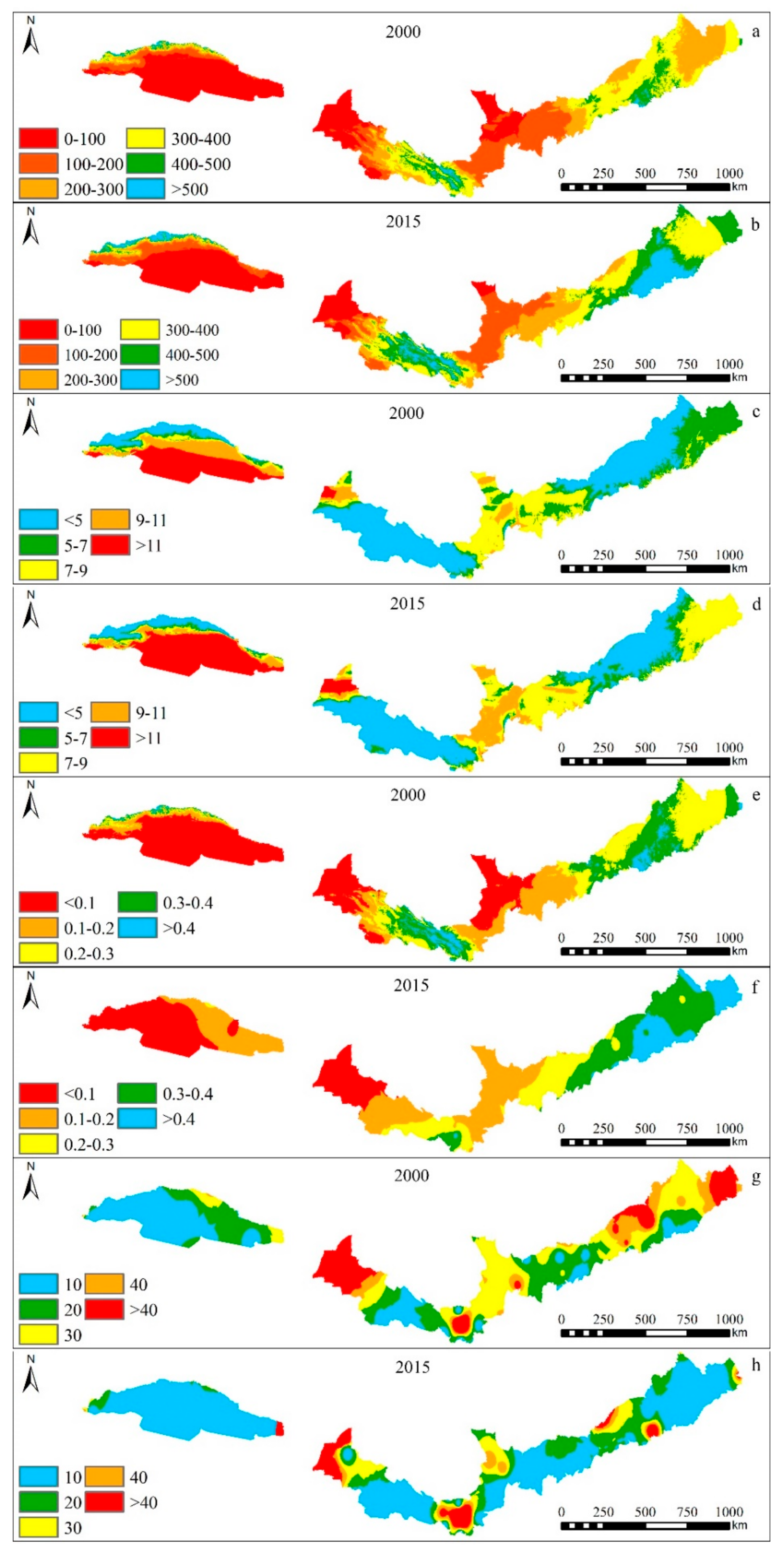
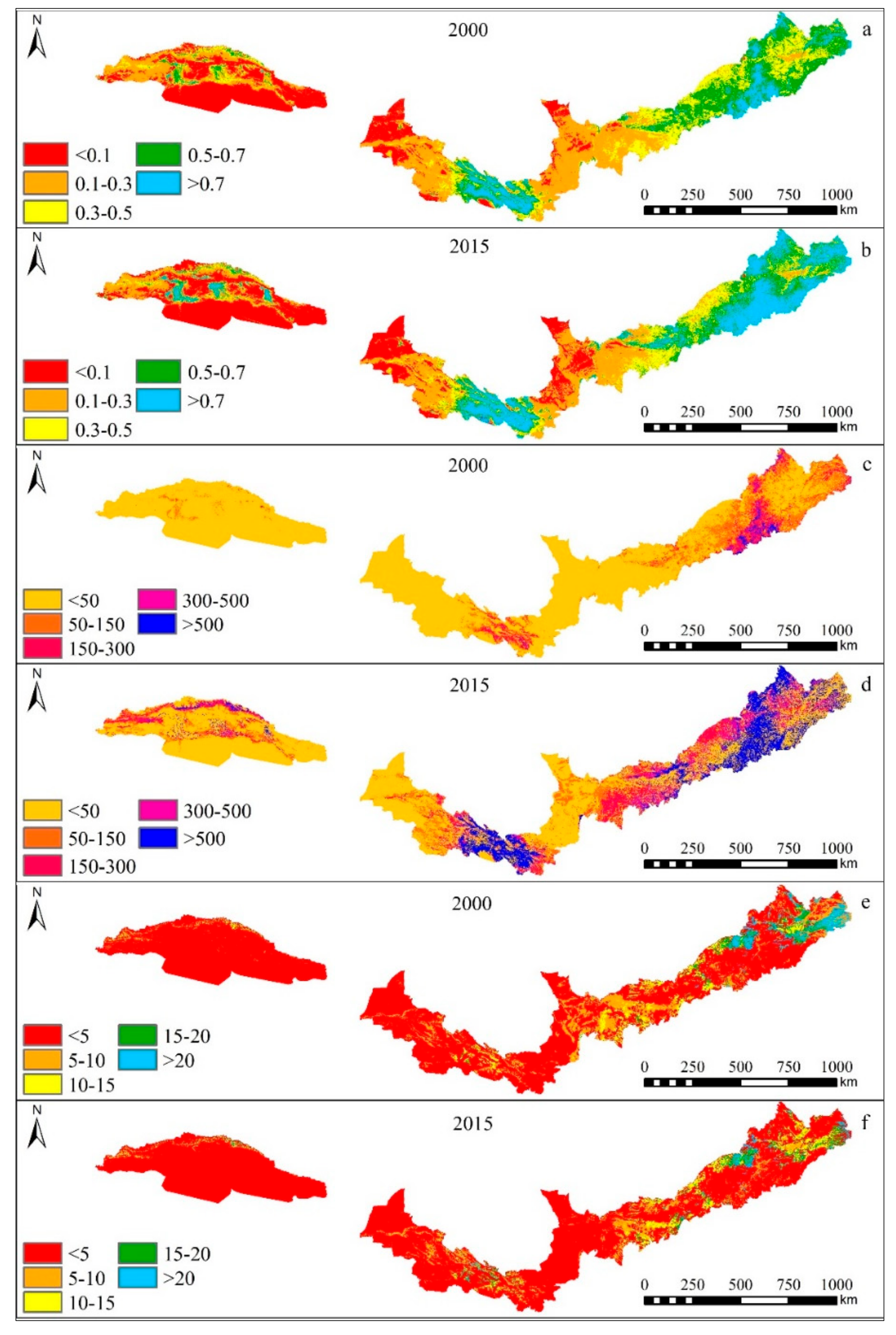
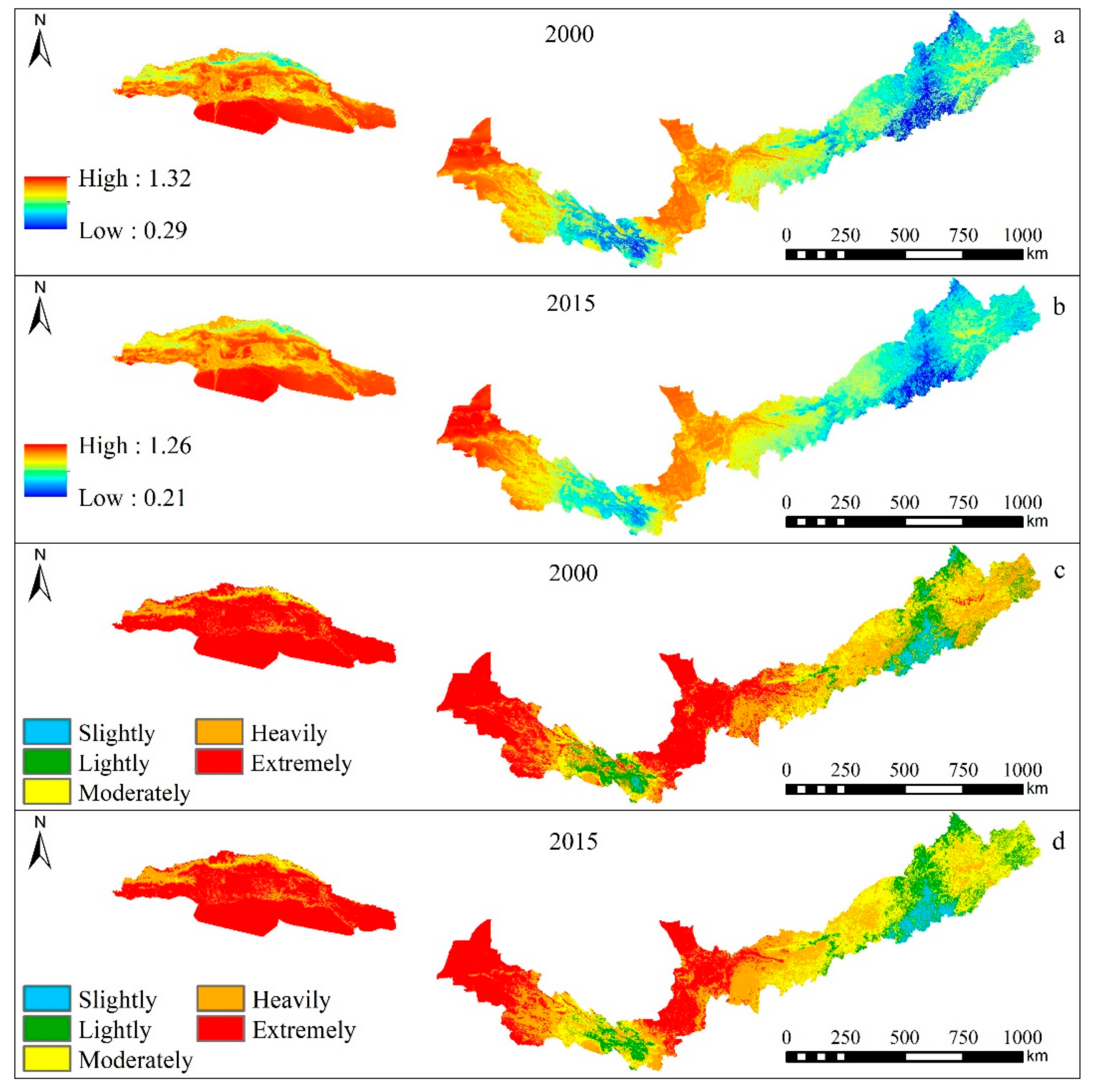
| Criterion Layer | Feature Layer | Indicator Layer | Attributes |
|---|---|---|---|
| Pressure | Human activity Pressure | Population density | Positive |
| Economic pressure | GDP per capita | Positive | |
| Sensibility | Terrain | Elevation | Positive |
| Slope | Positive | ||
| Earth’s surface | Soil erodibility factor * | Positive | |
| Land use types | Positive | ||
| Meteorology | Precipitation | Negative | |
| Temperature | Negative | ||
| Humidity index | Negative | ||
| Windy days | Positive | ||
| Resilience | Net primary productivity | Negative | |
| Vegetation coverage | Negative | ||
| Amount of sand fixation | Negative |
| Principal Component | 2000 | 2015 | ||||
|---|---|---|---|---|---|---|
| Eigenvalue | Contribution | Cumulative Contribution | Eigenvalue | Contribution | Cumulative Contribution | |
| 1 | 4.657 × 10−2 | 50.066 | 50.066 | 4.934 × 10−2 | 49.265 | 49.265 |
| 2 | 1.671 × 10−2 | 17.968 | 68.034 | 1.725 × 10−2 | 17.225 | 66.490 |
| 3 | 1.308 × 10−2 | 14.058 | 82.092 | 1.133 × 10−2 | 11.317 | 77.807 |
| 4 | 6.112 × 10−3 | 6.571 | 88.663 | 9.997 × 10−3 | 9.981 | 87.788 |
| 5 | 3.537 × 10−3 | 3.803 | 92.466 | 4.434 × 10−3 | 4.427 | 92.214 |
| 6 | 2.417 × 10−3 | 2.598 | 95.064 | 2.076 × 10−3 | 2.072 | 94.287 |
| 7 | 2.037 × 10−3 | 2.190 | 97.253 | 1.943 × 10−3 | 1.940 | 96.227 |
| 8 | 1.076 × 10−3 | 1.157 | 98.410 | 1.641 × 10−3 | 1.638 | 97.865 |
| 9 | 8.602 × 10−4 | 0.925 | 99.334 | 1.052 × 10−3 | 1.050 | 98.915 |
| 10 | 6.047 × 10−4 | 0.650 | 99.985 | 6.841 × 10−4 | 0.683 | 99.598 |
| 11 | 1.876 × 10−5 | 0.010 | 99.994 | 3.560 × 10−4 | 0.356 | 99.953 |
| 12 | 1.949 × 10−5 | 0.006 | 99.999 | 4.491 × 10−5 | 0.045 | 99.998 |
| 13 | 3.235 × 10−7 | 0.0001 | 100 | 1.890 × 10−6 | 0.002 | 100 |
| Year | Area (km2) | Percentage of Ecological Vulnerability Levels (%) | ||||
|---|---|---|---|---|---|---|
| Slightly | Lightly | Moderately | Heavily | Extremely | ||
| 2000 | 869,650 | 2.24 | 8.75 | 13.70 | 26.59 | 48.72 |
| 2015 | 869,650 | 2.33 | 10.04 | 21.85 | 23.57 | 42.21 |
Publisher’s Note: MDPI stays neutral with regard to jurisdictional claims in published maps and institutional affiliations. |
© 2021 by the authors. Licensee MDPI, Basel, Switzerland. This article is an open access article distributed under the terms and conditions of the Creative Commons Attribution (CC BY) license (https://creativecommons.org/licenses/by/4.0/).
Share and Cite
Li, X.; Song, L.; Xie, Z.; Gao, T.; Wang, T.; Zheng, X.; Liu, J.; Liu, L. Assessment of Ecological Vulnerability on Northern Sand Prevention Belt of China Based on the Ecological Pressure–Sensibility–Resilience Model. Sustainability 2021, 13, 6078. https://doi.org/10.3390/su13116078
Li X, Song L, Xie Z, Gao T, Wang T, Zheng X, Liu J, Liu L. Assessment of Ecological Vulnerability on Northern Sand Prevention Belt of China Based on the Ecological Pressure–Sensibility–Resilience Model. Sustainability. 2021; 13(11):6078. https://doi.org/10.3390/su13116078
Chicago/Turabian StyleLi, Xiufen, Lining Song, Zunbo Xie, Tian Gao, Tingting Wang, Xiao Zheng, Jiang Liu, and Limin Liu. 2021. "Assessment of Ecological Vulnerability on Northern Sand Prevention Belt of China Based on the Ecological Pressure–Sensibility–Resilience Model" Sustainability 13, no. 11: 6078. https://doi.org/10.3390/su13116078
APA StyleLi, X., Song, L., Xie, Z., Gao, T., Wang, T., Zheng, X., Liu, J., & Liu, L. (2021). Assessment of Ecological Vulnerability on Northern Sand Prevention Belt of China Based on the Ecological Pressure–Sensibility–Resilience Model. Sustainability, 13(11), 6078. https://doi.org/10.3390/su13116078






